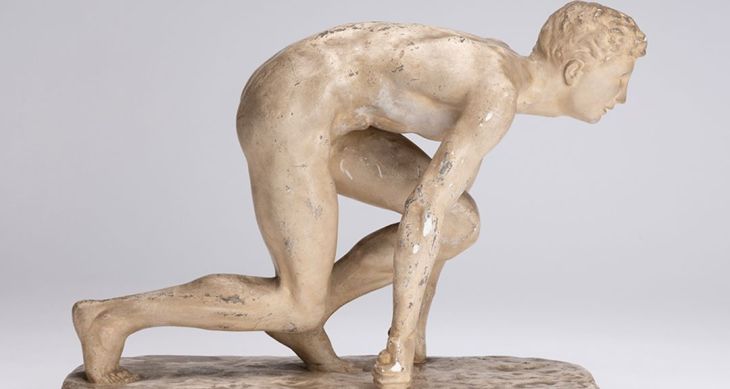Need for speed
One year too late, in 1925, the German company Leica, unveiled a game-changing invention, a camera with a rapid shutter speed. Sports photography would never be the same again. The exhibition features numerous photos from the 1924 Games, but as Young points out, “they look a little flat and not very dynamic.” The more exciting way to capture sport visually in 1924 was, he says, with drawing, painting, prints and sculpture.
In one room, Umberto Boccioni’s dynamic Futurist sculpture Unique Forms of Continuity in Space can be seen alongside a 1920s bobsleigh and breakneck footage of the 1924 bobsleigh event.
Dr Rebecca Virag, the exhibition’s Research Assistant, is equally excited to be showing an energetic series of postcards by French lithographer, H.L. Roowy.
“Graphic artists really came into play in 1924,” Virag says. “Roowy created advertising material for aeroplanes and cars alongside Ernest and Marguerite Montaut. The Montauts are credited with introducing a visual language of speed to portray the new motorised machines of the 20th century. For the Olympics, Roowy adopted similar cartoonish lines of motion to depict javelin throwers, rugby players and other athletes.”
Young points to a bronze sculpture by the German artist Renée Sintenis. In The Athlete (1926), Paavo Nurmi appears to defy gravity as he hits full stride. The Flying Finn’s fists clench, his muscles strain and his hair blows back. It’s a masterpiece and Young can’t wait to see it.
“Nurmi was renowned for not giving any interviews. As well as the Flying Finn, he was known as the Phantom Finn because no one could work him out. Poets, artists and journalists were all trying. Sintenis managed to create an intimate moment here.”
Young is pleased to have plenty of German exhibits in the show, not least because the Germans didn't go to Paris in 1924 – they weren't invited. George Grosz’s The Gymnast and Willi Baumeister’s Female Runner II emphasise what a powerful force German artists were in reimagining the human form in art at this time.
“Olympic events owed a massive debt to ancient Greece,” says Vout. “In 1924, that debt came up really aggressively against new ways of representing the body, ways that broke the body down into pieces. This was partly perhaps a response to the First World War and the disabilities which it caused. Modernism and classicism come into dialogue in ways that radically reform what we understand a human body to be.”
Classical sculpture dictated what the publicity for the 1924 Games looked like and the exhibition opens with plaster casts from Cambridge’s Museum of Classical Archaeology. But these stereotypically beautiful, idealised bodies are juxtaposed with footage of the real bodies of 1924 competitors, spindly legs and all.
Of Baumeister’s painting, Vout says: “Classical sculptures gave a template to follow or kick against when trying to represent a male athlete. But there were no such templates for female athletes. Apart from being nude, this runner couldn't be further from the classical. She has this long Mannerist form and really small head.
“She bursts out of the frame towards you, taking the bend at speed. And in the background you've got a reclining guy in little yellow Speedos, propped up on his elbow like a reclining Venus, and he just stares at her as she sweeps past. It’s an amazing picture.”
















